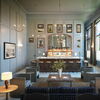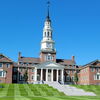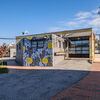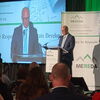
Camden considers affordable housing, maker spaces for old tannery site
 COURTESY / NORTHLAND ENTERPRISES, DOVETAIL CONSULTING
Seen here is a proposed site plan for the Millville Apartments in Camden.
COURTESY / NORTHLAND ENTERPRISES, DOVETAIL CONSULTING
Seen here is a proposed site plan for the Millville Apartments in Camden.
The town of Camden has four proposals to consider for redevelopment of a 3.5-acre former tannery site it owns at 116 Washington St.
Friends of Tannery Park submitted a proposal that would leave the site in the hands of the town. Midcoast Habitat for Humanity asked the town to donate some of the land for the construction of single-family affordable housing.
Rockland entrepreneur Michael Mullins, who owns commercial real estate company Cranesport LLC and a small business incubator in Camden, submitted a proposal to build Tannery Park, an “industrial eco-village” with maker spaces for entrepreneurs and an events barn.
Northland Enterprises LLC principal Joshua Benthien and Dovetail Consulting LLC principal Andy Jackson proposed Millville Apartments, an affordable-rental complex with amenities such as a fitness room and community room.
At the request of town officials, all of the proposals incorporate a farmers market that already operates on the site.
The site, on a residential stretch of Washington Street, has a history in manufacturing going back to 1855 with the construction of the Gould Plug and Wedge Mill. In 1887 it became the Camden Woolen Co. and employed 125 people. In 1953, the Camden Tannery Corp. took over. In 1997, it was leased to Apollo Tanning. The tannery closed in 1999 and the company sought bankruptcy protection in 2000.
The town acquired the property through foreclosure in 2003, demolished the building and cleaned up the site.

In 2018, the U.S. Environmental Protection Agency approved a $200,000 brownfields and land revitalization grant to the town for ongoing cleanup of the property. After a century of heavy industrial operations, contaminants include benzoapyrene and arsenic.
In 2019, the town began drafting a request for proposals to redevelop the site or a portion of the site. Camden residents will have the final say on redevelopment.
Board members have previously said redevelopment should not infringe on the farmers market and should contribute to the community good.
Tannery Park
Friends of Tannery Park is a community group working since 2014 to create a town park on the site. Its proposal is based on collaboration with the town, the farmers market and Midcoast Habitat for Humanity.
Redevelopment would provide space with recreational, social and educational uses and future additions to be built in phases as fundraising goals are met through donations and grants. Space would be sold to Midcoast Habitat for Humanity for two to three affordable homes.

The site is already used for activities such as dog walking and bicycling, Friends Chairman Tom Resek told the select board during a virtual workshop earlier this week.
Uses envisioned for the site could include dog walking, bike skills park, outdoor science classroom, pop-up marketplace, picnic grounds, wildflower and milkweed butterfly meadow, community gathering spot, preschool natural playground, pavilion, pickleball courts, skatepark, basketball court and ice skating rink.
No public park exists in Camden for preschoolers, said Resek, and the facility could help attract young families. Some features, such as bike tracks, would be built on the old tannery foundation, he noted.
A number of residents have signed up to work on various aspects of the proposal, he added.
The group has identified a future board of directors and is ready to establish a 501(c)3 nonprofit to handle funds, he said.
“This plan can proceed immediately,” said Craig Mudge, a Friends member. “We believe the plan responds to unmet needs in our community.”
The plan, while not exclusive, is primary designed for residents, not visitors, he added.
The Friends have over $70,000 in commitments for proposed improvements, said another Friends member, Paul Cartwright.
Resek said a bike park and preschool playground could be completed within two years.
The bike park was quoted at $50,000 for equipment and about $10,000 for installation, he said. The preschool playground could be about $10,000.
Selectmen said they were disappointed the group hasn’t gone further into financial projections.
“I like everything about it, but I’m disappointed that you’re not better prepared for this,” said Selectman Marc Ratner.
But Cartwright noted it made better sense to have the proposal approved first.
“It’s pointless to create a 501(c)3 unless you have a chance to do the work, and you can’t ask people for money unless you have the basis for doing this,” he said.
Millville Apartments
Northland’s Benthien said discussions with business owners and others revealed that lack of affordable housing is a major issue for Camden. He and Jackson proposed a range of 35 to 50 affordable housing rental apartments. The range depends on factors such as financing, construction costs, geometric constraints of the site, easements and what the town envisions as the best fit.
The apartments would be available to households earning 50% to 60% of area median income. Depending on household size, that’s families with incomes between $24,000 and $44,000 per year, said Jackson. Rent would be between $600 and just over $1,000 per month.
The market would be lower-wage earners, perhaps people already working in Camden who struggle find adequate housing, might have long commutes to more affordable communities, or might be paying a disproportionate share of their income on rent to live nearby, said Jackson.
Income restrictions would be deeded to the property for 45 years.
The two retained consultants for the site plan and budget development. The proposal includes purchasing the property for $85,000 and developing a public-private partnership with the town to adopt a tax increment financing district and a credit enhancement agreement that will return 75% of the incremental new property taxes for 30 years to support debt service.
Under the TIF, the remaining 25% will be retained by the town for its use, and the sheltering of the new property value will help the town because there would not be a reduction of state and county revenue sharing or school funding, according to the proposal.
Based on similar projects the two have worked on, it’s projected that annual property taxes would be $35,000, of which the town would refund $26,000 back to the project, which helps the project support a bigger mortgage, explained Jackson.
The site doesn’t generate any property taxes currently.
Midcoast Habitat
Tia Anderson, executive director of Midcoast Habitat for Humanity, said the nonprofit is asking the town to donate a portion of the land for the construction of two to three affordable single-family homes for sale to a low- to middle-income homeowners.
The energy-efficient homes would range from 1,200 to 1,500 square feet and would be in keeping with the style of the neighborhood, with modest yard space and parking for one to two vehicles.
Development costs for these homes are typically $135,000 to $155,000 with a typical market value of $235,000, according to the proposal.

With regard to financing, Midcoast Habitat has expanded its capacity over the last decade as a result of the creation of an affordable mortgage program with Camden National Bank and, soon, with other community bank partners, the proposal says. The funding model, along with Midcoast Habitat’s traditional in-house mortgage program, allows the group to have a continuous development process.
The group is currently involved in development of Philbrick Commons in Rockland, its largest project to date, with 12 houses constructed in two phases and a projected completion by year-end 2022.
Cranesport
Like the Friends proposal, the Cranesport LLC proposal is also called “Tannery Park.” It would be “an affordable industrial village” built from locally sourced, sustainable materials and focused on three primary uses: a common market, light industrial incubator spaces and event venue, according to the proposal.
A public plaza would be the permanent home for the farmers market and also host community events. A gateway “lawn and greenway” would preserve existing trees and open a lawn. Envisioned are 19 workshops for makers, artists and entrepreneurs. Other amenities include parking, facilities and utilities to support the farmers market, public seating and landscaping near the river, a restroom pavilion and a trash and recycling building.
“The purpose of this affordable industrial park is to foster entrepreneurship by offering workshops and spaces at affordable rents, below the market cost for purpose-built, freestanding commercial buildings,” the proposal says. “Tannery Park will offer flexible lease terms to support startups that have outgrown the proverbial ‘garage’ and are in the prototyping or early production phase, but are not yet ready to move into larger, purpose-built industrial space requiring a multi-year commitment.”
The proposed purchase price for the property is $250,000.

Mullins said the location is ideal for small entrepreneurs in a location close to downtown but away from tourism. Entrepreneurs would be in a like-minded community to work together on early-stage ideas.
“This is a special location,” he said. “I think you could capture some energy here and make Camden a place where things happen.”
The post-and-beam structures would be installed over helical piles that require minimal soil displacement.
Mullins proposed a phased approach to construction, probably building the infrastructure, barn and a third of the units first. But he hasn’t yet gauged demand for the maker space idea, he added.
“Once the infrastructure is in, it would be easy to drop the buildings in,” he added.
Selectman Taylor Benzie said the maker space idea “checks a lot of boxes” for Camden. “But housing affordability needs to be priority for the town right now,” he continued.
Mullins said he would be open to modifying the proposal to include “live/work” structures, with maker space on the ground floor and affordable units in the upper stories.
“The level of desperation is so high in Camden, that I’m pretty certain it wouldn’t be that difficult to fill a second-floor unit with people, even if they knew there would be somebody working there during the day,” Selectman Alison McKellar said of affordable housing demand. “Could we get you to guarantee a certain number of housing units?”
Mullins said that adding housing drives up costs.
“With this proposal, I’m trying to drive down the cost of the commercial spaces,” he said.
He suggested the town consider subdividing the site and allot a portion for affordable housing.










0 Comments